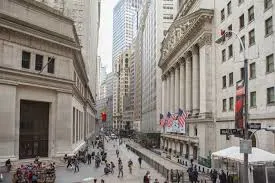Wall Street sees volatile trading as economic data triggers market fluctuations. Analysts weigh in on future trends and potential impacts on investors.
Wall Street Faces Volatility Amid Economic Data Fluctuations
In a turbulent trading session on Wall Street, U.S. stocks experienced notable volatility as investors reacted to a fresh batch of economic data that could significantly influence the trajectory of the market in the coming months. As the economy shows signs of shifting, analysts are closely watching indicators like inflation rates, employment figures, and GDP growth to gauge what lies ahead for both stocks and bonds.
Economic Data Triggers Market Movements
The primary catalyst behind the recent fluctuations in the stock market was the release of key economic reports. Data surrounding consumer spending, inflation, and employment numbers have been far from consistent, leaving traders and investors scrambling for answers. While consumer spending remains relatively robust, concerns persist regarding inflationary pressures and the Federal Reserve’s ongoing interest rate hikes.
Markets reacted swiftly to news of rising inflation, with major indices like the S&P 500 and Nasdaq Composite briefly dipping into the red. This volatility has become increasingly common as investors attempt to navigate the fine balance between economic growth and inflation containment.
“Inflation continues to be a major concern for Wall Street,” said Anna Davis, a senior economist at a global investment firm. “While the economy is still expanding, inflationary pressures are threatening to undermine that growth. The Fed’s response to this will be crucial in shaping investor sentiment.”

Interest Rate Hikes and Investor Sentiment
The Federal Reserve’s monetary policy remains a focal point in shaping Wall Street’s direction. The central bank has already raised interest rates multiple times in an effort to curb inflation, and further hikes could continue to pressure equity markets. Historically, rising interest rates can make borrowing more expensive and lower corporate profits, leading to reduced investor confidence.
However, some analysts believe that these measures, though painful in the short term, are necessary for long-term stability. “The market is experiencing growing pains as it adjusts to the Fed’s actions, but these steps are essential to bring inflation under control and preserve economic health,” said Davis.
The challenge lies in whether the Fed can achieve a “soft landing” — a scenario where inflation is brought down without triggering a full-blown recession. Many investors are still hopeful that this balance can be struck, but recent data has raised doubts.
Stocks Show Mixed Performance Across Sectors
While some sectors are being hit harder than others, there are a few bright spots on Wall Street. Technology stocks, in particular, have demonstrated resilience despite the overall market turbulence. With companies like Apple, Microsoft, and Alphabet continuing to report strong earnings and revenue growth, tech has been a safe haven for investors seeking stability.
Conversely, industries that are sensitive to rising interest rates, such as real estate and financials, have struggled to maintain momentum. Rising mortgage rates have dampened demand for housing, and banks are facing tighter profit margins as borrowing costs increase.
The mixed performance across sectors highlights the difficulty of navigating the current economic landscape. While some investors remain optimistic about the long-term outlook, others are taking a more cautious approach, rotating out of higher-risk assets in favor of more defensive stocks.
Wall Street Outlook: What’s Next?
Looking ahead, Wall Street faces considerable uncertainty. While some economic data points to steady growth, other indicators suggest that the economy may be slowing down. This divergence has left many investors unsure of how to position their portfolios for the future.
Analysts are keeping a close eye on upcoming economic releases, including GDP data and the latest consumer confidence surveys, to gauge how much momentum the economy has left. Additionally, the Federal Reserve’s next moves will play a critical role in shaping investor sentiment and determining the future direction of the market.
In the short term, volatility is expected to continue as traders react to new information. However, long-term investors remain cautiously optimistic, believing that the market will eventually stabilize once the Fed’s policies take full effect.

Conclusion
The volatility on Wall Street is a direct result of the complex relationship between economic growth, inflation, and the Federal Reserve’s monetary policies. As market participants try to read the tea leaves, it remains clear that navigating these turbulent waters requires careful consideration and strategic planning. With data-driven decisions becoming increasingly important, investors will need to remain vigilant in order to adapt to the ever-changing market conditions.





